The window frame is always narrower than the end of the wall, and the frame is mounted so that slopes are formed inside the room and from the side of the street. High-quality finishing of slopes for plastic windows in a wooden house increases the aesthetic perception of the house from the outside and is in harmony with the interior of the living space. The decoration is performed so that heat is retained, condensation does not appear, and the durability of the window block increases.
Functions and need for slopes

The side finish of the opening hides unsightly installation details and layering of polyurethane foam, the uneven surface of the casing and other defects.
In a wooden structure with plastic windows, finishing performs other functions:
- protects against drafts and external cold;
- prevents the appearance of mold, the development of harmful bacteria, fungi, microorganisms;
- protects against loud sounds, noise;
- prevents the formation of drops of condensation and dampness;
- increases the service time of the window cover.
The box is placed so that there is a distance between the casing and the frame, which equalizes the skew of the frame when the house of wood shrinks. The gap after fastening the window is sealed with foam, and after hardening, the protruding parts are cut off with a construction knife. External and internal finishing of the slopes protects the foam from destruction under the influence of atmospheric factors.
Slope classification
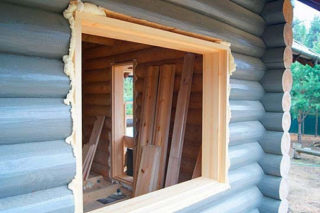
Wooden walls are made of a material that, after installation, reduces the percentage of moisture, unlike concrete and brick walls. Shrinkage depends on the climate in the region, the season, the purpose of the building and the internal microclimate.
In wooden houses, window frames are installed using a cage - an additional rigid box that levels the position of the window in the event of a subsidence of the structure. This should be taken into account when choosing the structure of the slope and the material for its manufacture. Such an element must be installed in houses made of timber, profiled or glued lumber, logs, and is used in frame-type buildings.
The thickness of the walls in a wooden house can be different, for example, the sizes of summer houses and capital log cabins differ. The facing of the slopes is attached to the wooden surface with self-tapping screws or screws. If a frame is mounted from a galvanized profile, self-tapping screws for metal with fine threads are used to connect metal parts.
By size
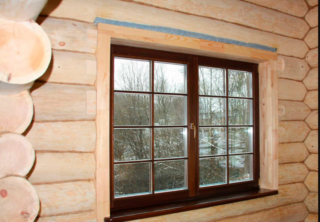
Slopes are made in size, which is due to the thickness of the vertical fence and the placement of the cover relative to the central axis of the wall in the plan.
The types are distinguished by size:
- wide - from 200 mm and above;
- narrow - 50 - 200 mm.
The window is often placed so that from the outside it is embedded in the wall shallowly, and inside there is more room for wide slopes and a window sill. Sometimes the box is placed flush with the facade, then the decoration is performed in the form of an overhead casing around the binding, metal, vinyl, acrylic or wood siding is used.
The space around the window inside can be finished in different ways, while taking into account that wide slopes require high quality materials, since they often crack and deform.
The finish looks good with wet wallpaper, cork, decorative plaster.The design provides for insulation, for which they put foam plastic, glass wool, extruded polystyrene foam panels. The waterproofing membrane is usually installed on the walls, and also comes with a vapor barrier film. These layers are placed inside the room and outside the building.
By location
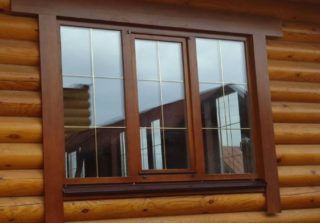
By location, planes are distinguished inside the building and from the side of the street. Each type works in different conditions, therefore, requires an individual choice of technology and material.
Internal surfaces are in gentle conditions of a certain microclimate, while the purpose of the room plays a role. In the kitchen, bathroom, the area is exposed to high humidity, active atmospheric impurities in the form of fat and acids. The finishing material is chosen taking into account aggressive factors. Surfaces in living quarters do not undergo such influences, they do not impose increased requirements on materials.
Outside slopes are exposed to temperature extremes, suffer from frost, and are heated by the sun's rays. The layer should not change color over time, become brittle and degrade. Opt for steel siding, plastic, high quality lining. The surface must withstand impacts and have high strength.
By form
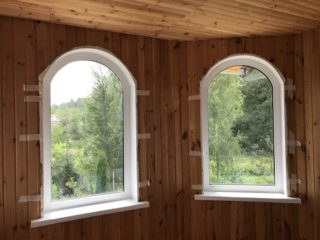
The vertical surface of the slope is made so that an angle of more than 90 ° is obtained between the end of the wall and the edge of the window sash, which the builders call dawn. The condition is fulfilled so that more light enters the room, while an angle of up to 45 ° is considered correct. Vertical planes should be performed with the same dawn, and the upper slope often differs in the angle of inclination, therefore, the identity by degrees is not observed for it.
Slopes at an angle of 90 ° without dawn can be made if it is not possible to turn the vertical plane. This happens if the dimensions of the window fit exactly the opening without the slightest gap, and the width of the box is minimal. These slope options create a depressing mood in the room.
The arched form of the slopes is finished with a wet method or sheet bendable panels are used. Plasterboard, plastic, siding are installed, and ceramic tiles are used. Internal arched surfaces are made with putty, followed by painting with colored acrylic compounds.
Finishing methods

Inside the house, the material is chosen depending on the style of the room and the interior decoration. In the bathroom and in the kitchen, plastic cladding or a surface lined with ceramics looks appropriate. These types are in harmony with the material of the walls made of tiles, the ceiling made of PVC, so they look organic and firmly resist the damp microclimate. The areas are easy to clean and free of fat (kitchen) hardness salts (bath).
For the slopes of living rooms, plaster is used, decorative putty is made. The surfaces are pasted over with wallpaper to match the room, but snow-white slopes that are suitable for any style always look better. Wooden slopes are suitable for country style and natural materials.
The planes around the windows from the street side are often performed with various types of siding, plastic, modern clapboard. The materials meet the requirements of work in difficult weather conditions and retain their performance characteristics for a long time.
Plastic
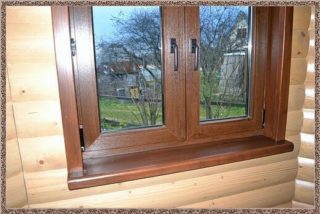
The material is placed outside and inside on the slopes when decorating windows in a wooden house. Practical PVC panels are distinguished by a long service life and an affordable cost. The surface has a glossy or matte shade, the user has the right to choose the plastic by color. Panels are produced with imitation of natural materials, for example, stone, different types of wood. On the surface, a pattern of ceramics, brickwork, fabric braiding is applied.
Plastic has high quality properties:
- the simplicity of the technology of installation and processing allows you to sheathe the planes with your own hands;
- easily cleaned with ordinary detergents;
- does not support the development of microorganisms;
- under normal conditions, it does not emit components harmful to health.
PVC plates are lightweight, so they do not increase the load on the walls. Plastic can withstand temperature fluctuations and heating by the sun, due to its moisture resistance, it does not collapse in the cold. Due to the honeycomb structure, they additionally isolate the room from noise.
Wooden
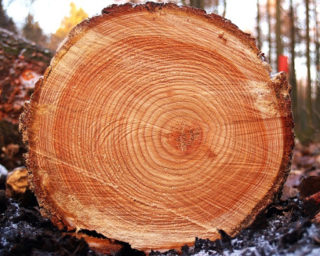
They use various species, for expensive interiors they put elite boards of oak, beech, cedar wood. As an inexpensive option, take coniferous species of pine and spruce. The average cost material is Siberian larch, which contains resin in the composition, which protects the material from moisture.
Positive qualities of wood in the decoration of slopes:
- environmentally friendly look, does not contain and does not emit harmful substances when heated from the sun;
- does not fade over time;
- creates an atmosphere of warmth and comfort;
- can be combined with many building materials.
Wood of any quality requires treatment with antiseptics, fire retardants, stimulants, so that bugs do not spoil it, and the risk of ignition of the finishing layer decreases. The material is rarely painted; impregnations and varnishes are often used to emphasize the original texture. Wooden slopes can last 2 - 3 decades without losing their original properties when properly installed and maintained.
Plastering
Standard plaster contains cement and sand in a 1: 3 ratio. It is an economical type of window decoration that behaves well outside and inside the home. Thin layers sometimes freeze.
Plaster does not adhere well to the wooden ends of the walls, therefore, be sure to stuff a metal mesh before throwing on the solution, and add gypsum or alabaster to the mixture in a volume of 1/10 of the mass. Liquid glass is mixed into the composition to increase moisture resistance. Finished surfaces are putty and covered with acrylic based water-based paints.
The modern market offers ready-made plaster mixes with increased adhesion to wood. Such formulations are sold ready-to-use, packaged in buckets or released as dry mixtures in bags of 25-30 kg. They contain polymer additives, fibrous impurities, which increase adhesion to wood and provide the elasticity of the coating. With the use of dry mixes, the cost of the layer increases.
Lining
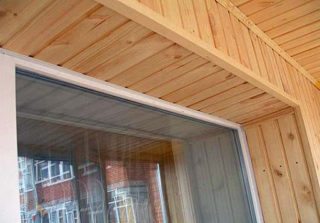
Glued material is made from wood fibers that are pressed under pressure under high temperature conditions. Modifiers and artificial types of resins are added to the mixture during production to improve performance. The material looks like natural wood after varnishing or impregnation.
For outdoor use, a lining of a complex composition is produced, which includes wood waste and polymer composites (polypropylene components). As a result, the elements receive fire-fighting characteristics and do not ignite up to a certain heating limit.
Modern lining serves up to 15 years, the material is easy to install, and does not require complex maintenance during operation. In normal household conditions, the panels do not emit harmful substances into the surrounding space. For the slopes of plastic windows in a wooden structure, the lining is a suitable cladding, since it is combined with the natural material of the walls.
Installation features
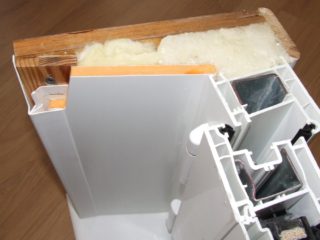
The peculiarity of wooden walls is that the opening for window installation always has a rectangular shape without distortions. The hole for installation is cut to size in a vertical fence, or the binding is placed in a ready-made casing with verified dimensions.
I provide insulation in any slope design. In frame cladding, it is easier to install the insulating material between the frame strips. For wet finishing layers, they also put protection from the cold, put a mesh of plastic or metal on it and throw a solution over it.
Installation of slopes begins after fixing the window sill inside. The ebb from the outside is installed after finishing the slopes. On plastic surfaces, siding, butt joints are treated with a sealant, this is especially important for external cladding. For fixing panels and sheet materials, you can use construction foam or liquid nails.








